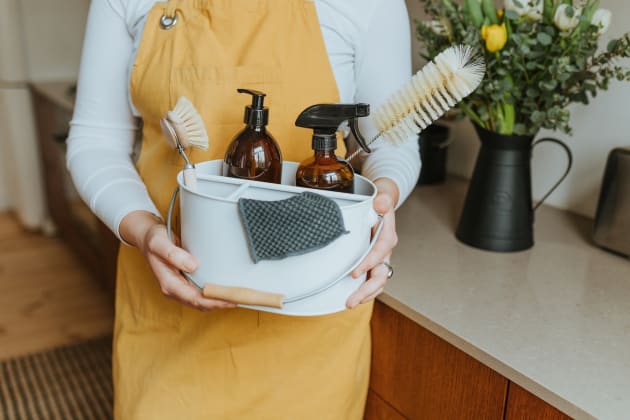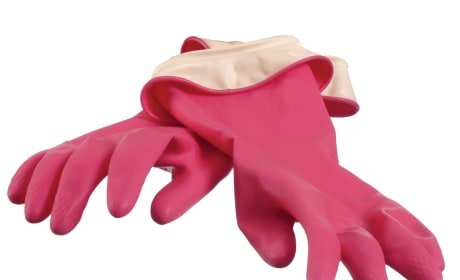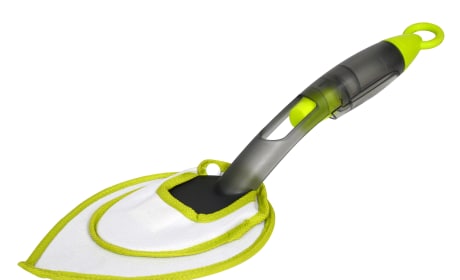How To Clean a GreenPan: Nonstick Pan Care Guide
Nicole AustinMake sure you're properly cleaning your GreenPan to keep it in prime condition.
There are a few simple methods you can use to best clean your nonstick ceramic cookware.
What Are GreenPans?
GreenPans are a ceramic nonstick cookware that has been around since 2007.
GreenPans are nonstick pans coated with Thermolon — arguably the best ceramic nonstick coating to be launched on the market.
Thermolon does not release toxic fumes, even if a pan is accidentally overheated, according to the company’s official website.
Third party testing labs have certified Thermolon as conforming to international regular food contact standards set by both the U.S. FDA and by E.U. regulators.
Thermolon coating is formulated using sand-derived raw materials which are turned into a solution that is sprayed on the pan.
Due to not containing dangerous elements such as lead, cadmium, or PFAS, GreenPans have soared in popularity.
You can find them at pretty much any major retailer, or directly on the company's website.
What Are PFAS?
PFAS are a group of over 4,700 industrial chemicals that are widely used in everyday products.
PFAS can be found in food packaging, toiletries, clothing, carpets, and traditional non-stick cookware.
PFAS are responsible for contaminating our blood, water, air, and food.
The Environmental Protection Agency's website lists a wide range of negative health effects of PFAS.
They are referred to as “forever chemicals” because they persist so long in the environment.
Some PFAS take over one thousand years to degrade. PFAS from today could affect generations to come.
While not all PFAS have been studied in depth, all of the ones that are have been determined to be toxic.
PFAS affect both humans and wildlife and are almost impossible to remove from the environment at this time.
Intentionally choosing to use products that are free of PFAS is a choice that will positively impact your household and the environment.
GreenPans are a great way to contribute to mindful use of safer cookware.
Tips for Cooking with Your GreenPan
Follow these 5 tips to preserve the quality of your cookware:
- Cook on low to medium heat. GreenPans use Thermolon, which distributes heat more effectively than traditional coatings. You can sear even thick cuts of meat on low to medium heat using a GreenPan.
- Use silicone and wood utensils. Silicone and wooden spoons or cooking utensils are softer tools to use on a pan than other materials and will help the coating of the non-stick surface last a long time as close to the original condition as possible.
- Use oil or butter. Oil and butter help distribute heat. High smoke point oils are best for high heat cooking. Examples of the best oils to use include: avocado, peanut, canola, sunflower, or sesame oil. Avoid spray forms of cooking oil, as the particulates will heat up quickly and burn. Besides the unpleasant odors and burnt food, this also leads to stuck-on food, a burnt pan, and an all around terrible cooking experience. If your oil or butter starts smoking, allow the pan to cool before cooking. Smoking is a sign that the pan is too hot.
- Allow the pan to heat. If you do not want to use a high fat product such as butter or oil to prepare your pan for cooking, allow the pan to heat for two minutes prior to cooking. This will help encourage even cooking and help prevent sticking.
- Do not use a knife on food while it is in the pan. This will help avoid scratching or damaging your GreenPan’s surface. Similarly, do not use electric or battery-operated beaters.
How to Clean a GreenPan
These popular ceramic pans require similar proper care to your other non-stick pans.
These tips can help you keep them in top shape.
Some GreenPans are dishwasher safe.
The product packaging should specify if the pan is safe to wash in the dishwasher. (You can also check the GreenPan website.)
However, the company advises hand washing whenever possible.
Hand washing will extend the life of your cookware.
GreenPans are easy to clean with a soft sponge and soapy, warm water.
You should avoid abrasive detergents, steel wool, or iron sponges. A dish sponge offers the best results.
You may occasionally use a small amount of baking soda to scrub your pan, but this is not a useful daily solution as it will eventually break down the nonstick surface.
Avoid plunging a hot pan into cold or cooler water. This results in thermal shock, which can warp a pan or shatter glass lids.
Allow your cookware to cool completely before washing. GreenPans can be prone to carbonization.
This is when overheating while cooking oils creates sticky residue in spots on your pan.
You can deep clean your pan to remove this residue.
How to Deep Clean Your GreenPan
Follow these steps to deep clean your GreenPan and keep it in good condition.
Traditional Method:
- Fill the pan halfway with water and bring it to a near boil for 2 minutes.
- Pour out the water and place the pan on a sturdy surface, such as a wooden cutting board.
- Carefully use a restoring (melamine) sponge on the warm surface.
- To clean the exterior, mix baking soda and a little water together in a dish to form a thick paste. Use a paper towel to rub the paste over tough stains. This is for exterior surface areas only.
Vinegar Method (Hot)
- Boil a 50/50 mix of white vinegar and water in the pan.
- Use a wooden spoon to remove stuck-on bits or residue.
- Allow to cool, and then soak the pan in soapy, hot water to finish releasing the food.
- Clean as usual after soaking.
Vinegar Method (Cold)
- Stubborn stains or stuck on food can be soaked overnight in a solution of water and white vinegar. Use 2 cups water and ½ cup vinegar and pour it into the pan.
- Allow to soak overnight, or at least 12 hours.
- Lightly scrub the food or stain using a melamine sponge.
Why Use Vinegar to Clean a GreenPan?
Vinegar as a cleaner is highly effective for many kitchen appliances.
While you may have used it to remove residue from your coffee maker, you may have forgotten that the usefulness of vinegar extends far beyond this capacity.
Vinegar is an excellent descaler and decalcifier, which is why it is a popular choice for cleaning items that easily build a residue with continuous use, such as a Keurig.
Pans, like microwaves, are good candidates for cleaning with vinegar because vinegar’s acidic qualities make it perfect for breaking down food that is harder to remove, due to being baked on or otherwise heated.
Additionally, vinegar can help clean your pans by combatting certain unique conditions such as hard water or limescale.
While vinegar works on fresher messes as well, such as fridge spills or countertops, there is a lot of value in using vinegar for hard to clean, stubborn messes.
Vinegar is great at removing grease and oils, and can help remove ugly brown stains from cooking surfaces.
Vinegar is also inexpensive, making it a great solution that is particularly fitting for your natural cookware — like GreenPans!
Product images courtesy of the GreenPan official website.
Nicole is a self-published author of fiction novels, and a lover of food and spending time in the kitchen with her six children. She lives in coastal Maine where she loves exploring new recipes especially those that can save time, money and wow a crowd.












